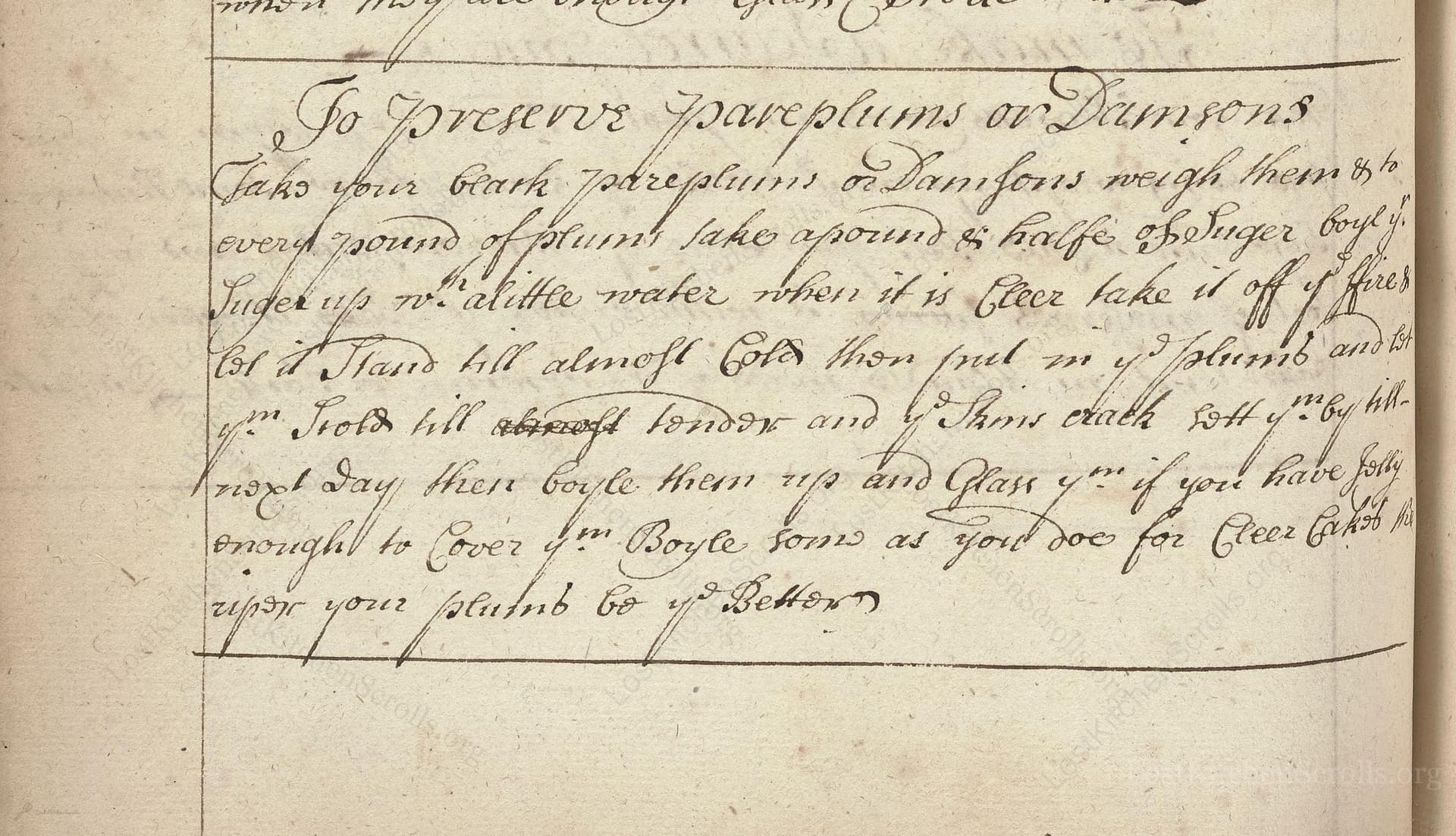To Preserve Pareplums Or Damsons
From the treasured pages of Cookbook of Grace Blome, Kent
Written by Grace Randolph

To Preserve Pareplums Or Damsons
"Take your black pareplums or damsons weigh them & to every pound of plums take a pound & halfe of suger boyle it with a litle water, when it is cleer take it of ye fire let it stand till almost Cold then put in ye plums and lett them stand till they are almost tender and ye skinns crack soft. then boyle them up and Glass them if you have not enough to Cover them boyle some as you doe for Cleer Cakes upon your plums to ye Better"
Note on the Original Text
The recipe uses non-standardized spelling and grammar, such as 'suger' for 'sugar', 'boyle' for 'boil', and 'ye' for 'the'. Amounts are given by weight, a practice common in preserving (and typical of the era). Instructions rely heavily on practical kitchen experience and observation – there are no timings, only visual and textural cues like 'when it is cleer' and 'skins crack soft'. Recipes were routinely passed down within households, written with the assumption that the cook had basic skill and access to high-quality, sometimes costly ingredients.

Title
Cookbook of Grace Blome, Kent (1697)
You can also click the book image above to peruse the original tome
Writer
Grace Randolph
Era
1697
Publisher
Unknown
Background
A delightful glimpse into late 17th-century kitchens, this culinary collection by Grace Randolph tempts taste buds with refined recipes and elegant flavors fit for a well-to-do English household. Journey through a banquet of historic treats and timeless techniques!
Kindly made available by
Folger Shakespeare Library
This recipe comes from Grace Randolph’s late 17th-century household collection, dating from 1697. In this era, sugar preserving was both a practical way to extend the season and a sign of household status. Glass jars weren’t as common as they are now; 'glassing' was a way to show off beautiful preserves to visitors, not just store them. Damsons and their relatives were beloved for their tart flavor and suitability for long-keeping. Such recipes were often written out for other household managers or daughters, forming part of a family’s archival culinary know-how. Using a pound-and-a-half of sugar to a pound of fruit was standard for making rich preserves at a time when sugar was expensive but valued for its preserving magic.

Historically, these preserves would be made in large brass, copper, or earthenware preserving pans, stirred with long-handled wooden spoons. The syrup was boiled over an open hearth or a coal/wood kitchen range. To store, glass jars or ceramic crocks would be used, sealed with leather, parchment, or waxed paper. Weighing would be done with scales and metal weights. Modern cooks might use heavy-bottomed stainless steel pans, silicone spatulas, and sterilized glass preserving jars with tight metal lids.
Prep Time
10 mins
Cook Time
15 mins
Servings
10
We've done our best to adapt this historical recipe for modern kitchens, but some details may still need refinement. We warmly welcome feedback from fellow cooks and culinary historians — your insights support the entire community!
Ingredients
- 2.2 lb damsons or small tart black plums (or substitute regular plums if unavailable)
- 3.3 lb granulated white sugar
- 5 fl oz water (approximate, just enough to dissolve the sugar)
Instructions
- Weigh your black damsons or prune plums (pareplums is an old word – regular damsons or any tart small plums will do).
- For every 2.2 lb of plums, use 3.3 lb of white sugar.
- Place the sugar in a large pan with just enough water (about 5 fl oz) to wet the sugar and help it dissolve.
- Bring this to a boil until the syrup is clear.
- Remove from the heat and allow it to cool until just warm.
- Add the whole plums to the syrup and let them soak until the skins have softened and started to split, and the flesh feels mostly tender – this can take several hours or overnight.
- Once the skins have cracked, gently bring the plums and syrup back to the boil, making sure not to break up the fruit.
- Simmer for a few more minutes until the syrup is thick and glossy.
- Carefully transfer the plums with their syrup into sterilized glass jars, making sure they are well covered.
- If there isn’t enough syrup to cover, prepare extra syrup as before and pour over the fruit until submerged.
Estimated Calories
230 per serving
Cooking Estimates
It takes about 10 minutes to prepare the ingredients, plus around 15 minutes of active cooking time. The plums need to soak in syrup for several hours or overnight, but this is mostly hands-off time. Each serving has about 230 calories, with this recipe making about 10 servings in total.
As noted above, we have made our best effort to translate and adapt this historical recipe for modern kitchens, taking into account ingredients nowadays, cooking techniques, measurements, and so on. However, historical recipes often contain assumptions that require interpretation.
We'd love for anyone to help improve these adaptations. Community contributions are highly welcome. If you have suggestions, corrections, or cooking tips based on your experience with this recipe, please share them below.
Join the Discussion
Rate This Recipe
Dietary Preference
Main Ingredients
Culinary Technique

Den Bockfisch In Einer Fleisch Suppen Zu Kochen
This recipe hails from a German manuscript cookbook compiled in 1696, a time whe...

Die Grieß Nudlen Zumachen
This recipe comes from a rather mysterious manuscript cookbook, penned anonymous...

Ein Boudain
This recipe comes from an anonymous German-language manuscript cookbook from 169...

Ein Gesaltzen Citroni
This recipe, dating from 1696, comes from an extensive anonymous German cookbook...
Browse our complete collection of time-honored recipes



